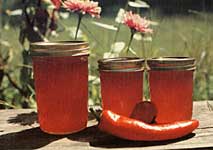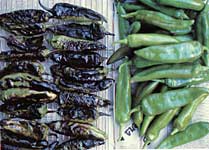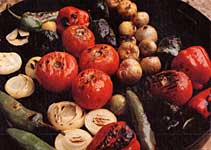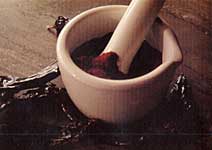Preserving Chiles
In midsummer, chile peppers mature, begin to ripen, and become more pungent. Some are fiery hot, while others are crisp, slightly sweet with just a hint of heat, and full of flavor. This is the time to put up that prize-winning corn relish, those pickled peppers, salsas of every kind, and hot pepper chutney.

Depending on the variety, it can take a few weeks for peppers to change color from green to ripe red. Peppers can be eaten no matter what their color, but your preserved chiles will taste best if you use fruits that are all approximately the same level of maturity and color—mature green or ripe red.
Whatever their color, it's always best to wear rubber gloves when working with chiles. Capsaicin, the pungent compound in chiles, can burn your hands, and then your eyes, mouth, nose, or anything else you touch.
Gather jalapeños and serranos while they are still green to make green hot-pepper jelly. Along with tomatoes, tomatillos, and herbs, pick an assortment of hot peppers and preserve a few batches of salsa and relish for the long winter months to come. To tell whether your green peppers are mature, slit one open and look at the seeds. They should be creamy white, big, and flat. If they are brown or not fully developed, the fruit is not yet mature.
You can eat red chiles raw, grill them, use them to make red chile jelly, or dry them whole for cooking. Smaller chiles ripen quickly in midsummer, especially Thai and cayenne peppers. Harvest them as they ripen and string them on thin wire to dry; you can then grind them or use them whole as decorations.
Roasting & Freezing Fresh Chiles

Green chiles don't dry well but you can preserve them whole by roasting or grilling and then freezing them. (If you freeze them without grilling, the chiles will become mushy.) Large green chiles are best for this method. Most thick-fleshed peppers—New Mexico green chiles, Anaheims, anchos, mulatos, and the sweet bells—have a thin, tough skin that is best removed for pleasant eating. The traditional method is to roast the peppers: They may blacken a little, and the skin will blister and become loose. Once roasted, these chiles will freeze well.
You can roast chiles in three ways, depending on the number you have to prepare. In all cases, cut a small slit at the stem end of the chiles to keep them from bursting. If you only have a few chiles, roast them directly on the open flame of a gas stovetop. Watch them carefully and turn frequently with tongs.
If you want to preserve a larger number of green chiles—say, six or more—place them in a shallow baking pan, and set it about 4 inches below the broiler. Turn frequently to blister the chiles evenly. Watch them carefully so that they don't overcook. The skin does not have to blacken to become loose; if it wrinkles when you push it with the tongs, the chile has been blistered enough.
If you have a large number of chiles to put up, outdoor grilling is an excellent method. The chiles will blister quickly and take on a smoky flavor. Roast the peppers on an open grill over hot coals, about 4 to 6 inches from the flame. Watch the chiles carefully and turn frequently. Roasting peppers usually takes about 4 to 5 minutes for each side, depending on the size of the peppers and the intensity of the heat. Larger peppers will take longer to roast and need to be turned more often. When the chiles are done, the skin should be blistered and charred all over.
As each chile is done, transfer it with tongs to a rack over a baking pan. When all the chiles have cooled to room temperature, place them on a metal pan or a cookie sheet and freeze until they are hard. Transfer the chiles to plastic freezer bags, label and date them, and store them in the freezer.
To use the frozen chiles, thaw them for about an hour. Their skins will slip off easily, and the seed membranes will also be easy to cut after freezing. Chiles taste best and have a fresher texture if you eat them within the first six months. If you remove as much air as possible from the freezer bags and have a reasonable freezer, frozen chiles are still quite tasty up to a year later.
If you plan to eat your chiles fresh rather than freezing them, you can peel them by roasting and then steaming them. Put your roasted chiles in a paper or heavy plastic bag, or wrap them loosely in foil to steam the skins loose. Let the peppers steam in the bag for 5 to 10 minutes. Tear open the bag and use it as your work surface so you can keep cutting boards free of chile juice, skins, and seeds. Begin by loosening the skin at the stems where you made a small slit. When the skin is loosened all around the stem, scrape it down with the flat of a knife, turning the pepper as you scrape.
To prepare roasted, skinned chiles for stuffing, cut a slit down the length of the chile, from the stem to about 1/2 inch from the end. Cut the seed membrane free just under the stem. Parts of the membrane extend down the inner walls; run the knife under these to free the chile of membranes and seeds. Don't worry about a few seeds or blackened bits of skin, and don't rinse your roasted chiles, as this causes them to lose flavor.
If you are not stuffing the chiles, it is easier to simply cut the seed membrane and stem together, even though you lose a little chile flesh. If you simply cut out the pithiest part of the membrane, which holds the seeds, you will not lose much pungency.
Now the chiles are ready for any number of preparations. They can be stuffed, diced, or cut into strips, made into salsa, or canned. (For culinary uses of individual chiles, see "Encyclopedia of Chiles," page 68.) Since the chiles have already been partially cooked, they need little further cooking. For the best flavor, 15 to 20 minutes of cooking are enough for most dishes.
Harvesting, Drying, and Saving the Seeds of Chiles

Toward the end of the harvest season, when most of the chiles on the plants have matured to red, it is time to pick and dry chiles or to pull the plants and hang them to dry. Pick the peppers while they are still firm and crisp—before they begin to get soft or wrinkly. Red and completely mature chiles will be at their peak of pungency, so wear rubber gloves when working with them.
Keep a close watch on your peppers when they are in their red, ripe stage. If you see any moldy or soft, black spots on the peppers, dispose of them immediately. If the weather is wet, try to harvest the peppers as soon as the sunshine dries them, before they begin to mold or rot on the vine.
Dried chiles taste completely different from fresh chiles. They are generally earthier and have a chewy texture. The Southwest is the perfect place for drying chiles. Hot sun, dry air, and warm nights with little chance of precipitation provide the ideal conditions. However, witih a little help from the oven, chiles can also be dried in more humid climates.
Small chiles dry well if you pull the whole plant and hang it upside down in a well-ventilated place. You can also dry smaller peppers by spreading them in a single layer on screens or in large flat baskets, and turn them every day so that they dry evenly. Or, with a needle, you can run a thread through the stems or use a thin wire, and hang them to dry.
Larger peppers with thicker walls take longer to dry. You can spread them on screens or baskets to dry, or make them into ristras—large strings of chiles tied by their stems with heavy string or twine and hung in the hot sun to dry. Ristras are common in the Southwest and Mexico, where these heavy, fat strings of deep red chiles are hung outside from rafters and doorways. Ristras are often used decoratively; if you plan to use them for cooking, once they are thoroughly dried, bring them inside and hang them away from direct sunlight.
If you live in a climate where the temperature and sunlight are uneven and the humidity is high, you can dry your chiles in the sun, but bring them indoors at night or if it rains. Peppers are likely to mold if they get damp or wet during the drying process.
The size of your chiles, the thickness of the flesh, and weather conditions all determine the drying time, which can vary greatly. In the Southwest, where the humidity is low and the sunlight is bright and even, peppers sometimes dry in less than a week.
In humid climates, you can dry chiles partially in the sun and finish them off in a 150° oven; spread them on baking sheets and turn them occasionally. This could take anywhere from 1 to 12 hours, depending on the size and moisture content of the chiles. Feel your chiles to tell if they are thoroughly dried: They should be free of moisture and feel leathery rather than brittle.
Store dried chiles whole in labeled, tightly closed glass jars.
To save chile seed for next year, remove the seed from raw, mature peppers, rinse, and place on paper towels or a small piece of screen. Dry seeds in the sun, in a protected place. When thoroughly dry, pack them into plastic bags, envelopes, or small jars, and label them. Store them in a cool place away from light.
Grinding Chile for Spices

Pure ground red chile is made from dried chiles and nothing else. This is an essential ingredient in Southwestern and Mexican cooking; it is used in making red sauce for enchiladas, burritos, and huevos rancheros, among other dishes.
To prepare ground red chile, toast the peppers lightly (although tiny chiles like chiltepins and piqu'ns don't need to be toasted). Use a comal—a large iron griddle for making tortillas—a regular griddle, or a heavy frying pan and toast the chiles over medium heat until they just start to release some fragrance, only about 30 to 60 seconds. Do not overtoast them, or they will have a bitter taste. Stem and seed the chiles, and tear the pods into big pieces. Grind the pieces, about 1/2 cup at a time, in a food processor or blender. Do the fine grinding in small batches using a spice grinder, coffee mill, or mortar and pestle. Store the ground chile in tightly closed jars away from heat and sunlight. You can also freeze it for up to one year.
Chili powder is different from ground red chile. This American mixture was created in Texas in the late 1800s. Dried chiles are the main ingredient, enhanced by spices and herbs—mainly cumin and oregano, occasionally black pepper, dehydrated garlic, and onions. The original chili powders were pure, without the salt, anticaking agents, or flour that characterize many modern blends.
It's easy to roast your own chiles, grind them as for ground red chile (above), and experiment with herbs and spices to make your own version of chili powder.
Homemade chili powder will keep in a tightly sealed jar out of direct sunlight for six months.
Small Chiles and Ornamentals
Ornamental peppers delight the palate as well as the eye. They add a fiery pungency in cooking and are especially lovely on miniature herb wreaths and kitchen swags, or threaded and hung in miniature garlands. Look for them in seed catalogs under such entertaining names as 'Candlelight', 'Fiesta', 'Fips', 'Fireworks', 'Holiday Cheer', 'Holiday Flame', 'Inferno Mixed', 'Jigsaw', 'Midnight Special', 'Pequin', 'Tepin', and 'Treasure Red'.
You can use these small chiles fresh or, when they ripen to red, you can dry them in baskets and store them in glass jars for future use. Harvesting will stimulate new growth.
All of these little peppers are hot; most of them are fiery. Novices should beware the pungency of these incendiary little peppers.
Because they are so hot, they are most often used whole—simmered in soups or stews, briefly sautéed in stir-fries, or soaked in a marinade—then removed.
Vinegars and Infusions
If you have a surplus of the smaller hot peppers, you can pickle them or, to add new flavors to cuisine, infuse them in vinegar, vodka, tequila, or sherry. Choose fresh, unblemished chiles or small, brightly colored, dried ones. You can use any type of chile in an infusion, but you are sure to succeed with the traditional varieties: serrano, cayenne, jalapeño, 'Santa Fe Grande', red hot cherry, tabasco, Thai, and the ornamentals. Both liquor and vinegar infusions keep for at least one year.
Wash the fresh chiles and make a lengthwise slit in each pepper, fresh or dried, with a sharp paring knife (otherwise they will float like a cork). If you cut the fresh chiles in halves or quarters, there will be more heat in the infusion.
To make a liquor infusion, halve or quarter the chiles and push them down into the neck of the bottle. (You may have to pour out a little bit of the liquor if the bottle is full.) Use two chiles to a half dozen, depending on their heat. I generally use two or three habaneros to a liter bottle of good tequila. Two or three green jalapeños are good for flavoring a bottle of sherry, but I like to put five or six red cayennes or serranos in a bottle of vodka. Do not heat the alcohol. The chiles will float at first, but eventually sink. Allow the infusion to stand for 3 to 4 weeks before using.
Vinegars add zest to salads, sauteés, and marinades, and are essential in making escabeche, pickled dishes made with vinegar or lime juice. Hot pepper vinegars are made in basically the same way as liquor infusions, except the vinegar is generally heated.
Place your choice of peppers in a large, nonreactive, heavy-bottomed saucepan. If preparing pint jars, use about 1 cup of chiles per jar, and if preparing quarts, use about 2 cups of chiles per jar. Using about 1/2 cup less liquid than the size of the jar (for example, 11/2 cups liquid to a pint jar), pour the vinegar over the chiles. Let the chiles and vinegar come to a boil, reduce heat, and simmer 3 to 5 minutes, then cool to room temperature. Transfer the hot chile vinegar into sterile 1-pint or 1-quart canning jars, leaving about 1/2 inch of space at the top. You can add a few sprigs of herbs such as thyme, oregano, or sage, if desired. Seal the jars with sterile lids and rings, and set them in a pantry or a cool, dark place for 2 to 3 weeks before using. These infusions become hotter with age.


